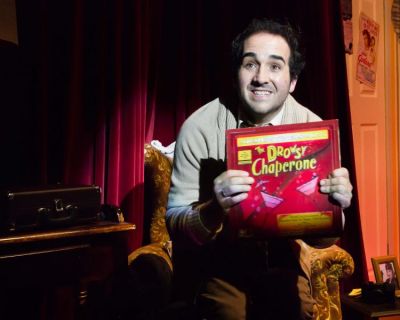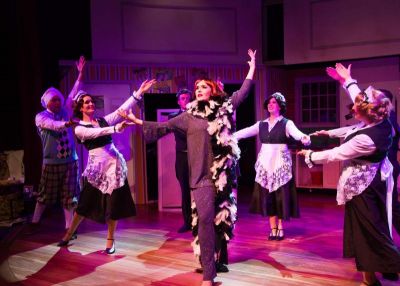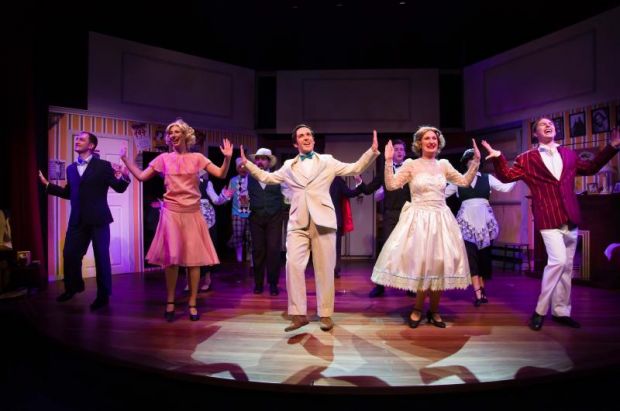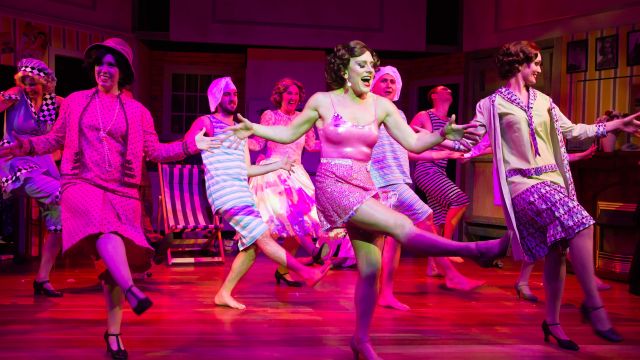The Drowsy Chaperone
Do you ever recognise yourself as you sit watching a musical?
I confess that I can see more than a little bit of myself in obsessed musical theatre tragic Man In Chair. Passionate about every last scrap of trivia, and narrating this delightful flight of fantasy pastiche, his mundane world merges with a theatre-of-the-mind performance of a (guilty) favourite (fictitious) 1920s musical comedy, as he sits in his apartment sharing the cast recording with us. Not merely breaking, but totally dismantling, the fourth wall, David Verdejo’s Man In Chair is a delight, nerdishly navigating our journey, joining in on the action when it takes his show queen fancy, as the musical springs to life in his shabby apartment.
The 1920s was a decade when you’d expect at least 50 musicals to open on Broadway each year, with even more trying their luck out of town. It’s the era when the Gershwins and Rodgers and Hart reigned supreme, yet the fictitious 1928 musical of the title, The Drowsy Chaperone, reconstructs a distinctly B Grade alternative, with far less illustrious composers, lyricists and book writers.

This affectionate pastiche of an age of musical theatre long gone positively effervesces with musical comedy clichés, formulaic plot devices, unbelievably corny songs, stock characters and over the top performances, all attacked with relish.
Everyone on stage has a whale of a time hamming it up, though as in any show as farcical as this one, it’s the performances invested with absolute belief, no matter how zany the behaviour that’s called for, which satisfy most. Moving inside the frame of the show-within-a-show, and beyond David Verdejo’s marvellous performance, I’d like to highlight some of those performances.
As leading lady Janet van de Graaff, Alisia Jedrzejczak gives a wonderful performance, constantly inhabiting her role, and even eliciting genuine empathy as she communicates heartbreak while delivering the seemingly inane lyrics of her lament. Chewing up the scenery as over-the-top Latin lover Aldolpho, Luke Baweja matches that level of belief in his character no matter how outrageous his behaviour becomes. Playing the titular Drowsy Chaperone, Andrea van den Bol blitzes her role with aplomb and belief, nailing her big act one anthem “As We Stumble Along” with a deliciously husky belt. Benjamin Lea seems to channel Dick Powell, from all those 1930s Hollywood musicals, as leading man and bridegroom Robert Martin. Kate Reynolds’ Kitty is the archetypal ditzy blonde, wanna-be-soubrette chorine. Man In Chair casually writes off the 1920s actors playing the gangsters (disguised as pastrycooks) as not being particularly scary, and Victor Aguilera and Lachlan Ceravolo carry off this description well. Harrison Jones also impresses as knowing manservant underling.
 Only David Verdejo’s Man In Chair should be breaking the fourth wall, but some other performers seem to have stylistic lapses, telegraphing moments when they’re clearly aware that they are in a send-up. It’s a minor concern, though, and scarcely diminishes the fun.
Only David Verdejo’s Man In Chair should be breaking the fourth wall, but some other performers seem to have stylistic lapses, telegraphing moments when they’re clearly aware that they are in a send-up. It’s a minor concern, though, and scarcely diminishes the fun.
With farce elements timing is vital and I couldn’t help feeling that the timing of opening the fridge door, a gag built into the set, was just that beat or so too early to really work. Our quick on his feet Man In Chair, David, however, proved several times that he could create alternate laughs and ad libs when a sight-gag didn’t quite come off, or a wall wobbled.
The dingy apartment setting is aptly designed by Alan Roy, complete with its reveals, which colourful, highly theatrical costumes and wigs by James Worner, Beth Pilley and Kelly Horrigan instantly transform as Man in Chair flicks the switch into his theatre of the mind.
Andrew Beban’s concealed band capture the feel of period accompaniments superbly, and while the co-choreography of Olivia Cathro and Cameron Beard wasn’t terribly exciting at first glance, it set me wondering whether, perhaps, the slick choreography of the professional incarnations of this show may have been somewhat better than the originals they were sending up.
Reference to classic Greek Drama may seem like a stretch, but Chloe Horne (who has already proven the show’s outstanding ensemble dancer) delights as Trix the Aviatrix, landing her plane “Deus ex Machina (god on a crane)” style to resolve the ludicrous plot complications in the obligatory happy-ending finale.
A fun, snappy entertainment, so reminiscent of other joyous, affectionate musical genre send-ups like The Boyfriend, Little Mary Sunshine and Dames at Sea that I so love, not to mention the originals that inspired them.
Neil Litchfield
Photographer: Alan Roy.

Subscribe to our E-Newsletter, buy our latest print edition or find a Performing Arts book at Book Nook.

